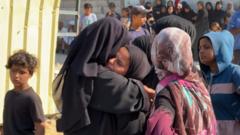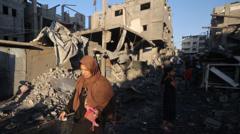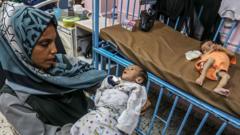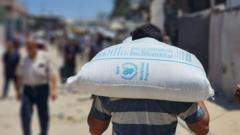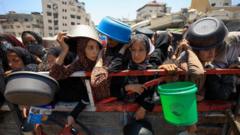Over two million Palestinians face a looming starvation crisis as aid efforts are scrutinized.
**Inside the GHF Food Aid Boxes: Addressing Hunger in Gaza Amidst Crisis**
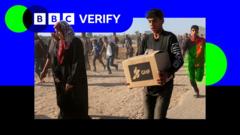
**Inside the GHF Food Aid Boxes: Addressing Hunger in Gaza Amidst Crisis**
Exploring the contents and nutritional adequacy of food distribution in war-torn Gaza.
The humanitarian situation in Gaza remains dire as reports indicate that over two million Palestinians are confronted with a severe starvation crisis, exacerbated by rising malnutrition-related fatalities. This emerging disaster has provoked urgent interest in the contents of food aid boxes distributed by the Gaza Humanitarian Foundation (GHF), which has been active since late May and claims to have provided 91 million meals.
Access to the boxes has been restricted for international journalists due to Israeli policies, hindering firsthand observation. In lieu of this, BBC Verify has scrutinized images and videos circulated online, along with insights from aid professionals regarding the nutritional standards of the aid being offered by the GHF.
The aid packets mainly consist of dried food necessities like pasta, lentils, chickpeas, and wheat flour, requiring water and fuel for preparation. In addition, the boxes include items such as cooking oil, salt, tahini, and occasional ready-to-eat items like halva bars. A GHF-provided data chart outlines each box as containing approximately 42,500 calories, enough to sustain 5.5 individuals for around three and a half days. Alternative items such as biscuits, tea, and chocolate can sometimes accompany the standard provisions, alongside fresh potatoes and onions that won’t factor into the nutritional analysis.
However, experts assert that these food boxes possess "serious weaknesses." According to Professor Stuart Gordon from the London School of Economics, while the aid can momentarily satisfy hunger, it lacks essential nutrients and is essentially a stopgap measure for acute hunger. He emphasizes that dependence on such a limited diet may lead to "hidden hunger," heightening the risks of diseases like anaemia and scurvy.
Dr. Andrew Seal, a nutrition authority from University College London, echoed these concerns, identifying deficits in critical nutrients including calcium, iron, and various vitamins necessary for the health of vulnerable populations, particularly young children. Unlike GHF, mainstream humanitarian groups like the UN typically distribute comprehensive food supplies combined with targeted nutrition interventions.
As for logistical challenges, recipients of the boxes are facing an alarming scarcity of water and fuel necessary for cooking. The United Nations Office of Humanitarian Affairs has alerted that water shortages are deteriorating rapidly in Gaza, with families resorting to unsafe and unhealthful cooking methods.
The UN, alongside organizations like the World Food Programme, reports on the escalating issue, revealing that malnutrition is soaring, with roughly 90,000 women and children needing urgent treatment. UN Secretary-General António Guterres cautioned this week that the humanitarian plight continues to deepen, underpinning the desperate need for adequate, nutrient-rich food supplies amidst ongoing conflict and blockades.
Access to the boxes has been restricted for international journalists due to Israeli policies, hindering firsthand observation. In lieu of this, BBC Verify has scrutinized images and videos circulated online, along with insights from aid professionals regarding the nutritional standards of the aid being offered by the GHF.
The aid packets mainly consist of dried food necessities like pasta, lentils, chickpeas, and wheat flour, requiring water and fuel for preparation. In addition, the boxes include items such as cooking oil, salt, tahini, and occasional ready-to-eat items like halva bars. A GHF-provided data chart outlines each box as containing approximately 42,500 calories, enough to sustain 5.5 individuals for around three and a half days. Alternative items such as biscuits, tea, and chocolate can sometimes accompany the standard provisions, alongside fresh potatoes and onions that won’t factor into the nutritional analysis.
However, experts assert that these food boxes possess "serious weaknesses." According to Professor Stuart Gordon from the London School of Economics, while the aid can momentarily satisfy hunger, it lacks essential nutrients and is essentially a stopgap measure for acute hunger. He emphasizes that dependence on such a limited diet may lead to "hidden hunger," heightening the risks of diseases like anaemia and scurvy.
Dr. Andrew Seal, a nutrition authority from University College London, echoed these concerns, identifying deficits in critical nutrients including calcium, iron, and various vitamins necessary for the health of vulnerable populations, particularly young children. Unlike GHF, mainstream humanitarian groups like the UN typically distribute comprehensive food supplies combined with targeted nutrition interventions.
As for logistical challenges, recipients of the boxes are facing an alarming scarcity of water and fuel necessary for cooking. The United Nations Office of Humanitarian Affairs has alerted that water shortages are deteriorating rapidly in Gaza, with families resorting to unsafe and unhealthful cooking methods.
The UN, alongside organizations like the World Food Programme, reports on the escalating issue, revealing that malnutrition is soaring, with roughly 90,000 women and children needing urgent treatment. UN Secretary-General António Guterres cautioned this week that the humanitarian plight continues to deepen, underpinning the desperate need for adequate, nutrient-rich food supplies amidst ongoing conflict and blockades.

